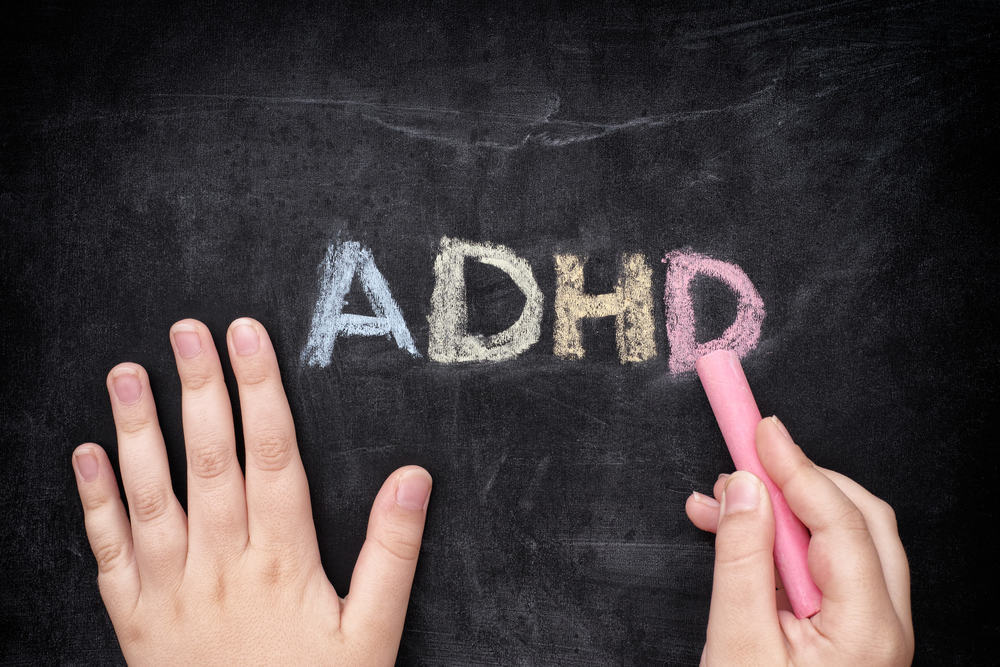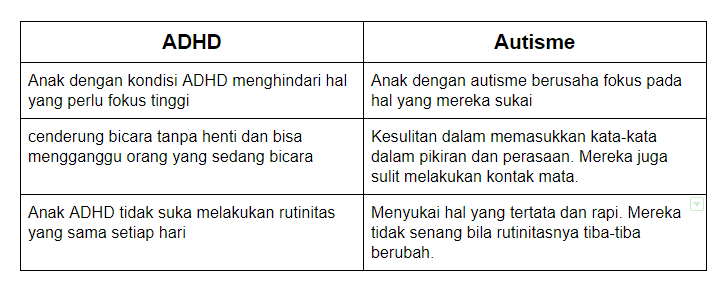Definition, Symptoms, Causes, and Treatment

Definition
What is ADHD?
Attention-deficit hyperactivity disorder or ADHD is the most common childhood neurodevelopmental disorder. This condition is usually first diagnosed as a child and can last into adulthood.
Children with this condition usually have problems seeking attention, controlling impulsive behavior (can act without thinking about the consequences), and are overly active.
The three subtypes of ADHD are:
- Dominant hyperactive-impulsive
People with ADHD who are predominantly hyperactive-impulsive predominantly have problems with hyperactivity and impulsive behavior.
People with ADHD who are more inattentive-dominant usually have symptoms of being unable to pay attention properly.
- The combination of hyperactivity-impulsivity and inattention
This group has symptoms of hyperactivity, impulsivity, and inattention.
What is the difference between ADHD and autism?
Children with ADHD and autism both have problems with attention.
Their behavior likes to change suddenly (impulsively) and also has difficulty communicating. They have problems relating to other people.
The difference lies in several things, namely attention, social interactions, and habits.

Symptoms
What are the signs and symptoms of ADHD?
The American Psychiatric Association calls the symptoms of this condition:
- Lack of attention (unable to stay focused).
- Hyperactivity (so much movement that you can’t stay still).
- Impulsivity (hasty action that occurs without thinking).
Many of the symptoms of hyperactive children, such as high activity, difficulty staying still for long periods, and limited attention span, are common in young children.
The difference between hyperactive children and other children is that their levels of hyperactivity and lack of attention are higher than most children.
It can also cause distress or problems at home, at school, or in a friendly environment.
By type, the symptoms that people with ADHD cause are:
Dominant incidence
People with this condition usually experience:
- Not paying attention to details or making careless mistakes on school or work assignments.
- Having trouble focusing on a task or activity, such as in class, conversation, or long reading.
- Like not listening to the other person.
- Not following directions and not completing school or work assignments.
- Avoiding or disliking tasks that involve ongoing mental effort (preparing reports and filling out forms).
- Often loses items needed to complete tasks or carry out everyday life.
- Easy to get distracted.
- Forgetting everyday tasks.
- Have trouble organizing assignments and jobs.
Examples of having problems managing tasks and work include not being able to manage time well, messy work, and skipping deadline).
Dominant hyperactive / impulsive
People with this condition usually experience:
- Fidget with tapping your hands or feet, or writhing in a chair.
- Cannot sit still (in class, or work space).
- Run or climb where it shouldn’t.
- Not being able to play or do leisure activities in peace.
- Always “on the way”, as if driven by a motorbike.
- Too much talking.
- Answering before the question is finished (interrupting the conversation).
- Difficulty waiting for your turn when waiting in line.
- Interrupt others
Such interruptions, for example in conversations, games, or activities, use other people’s things without permission.
There may be signs and symptoms not listed above. If you have concerns about a particular symptom, consult your doctor.
Child development and ADHD
The Mayo Clinic says that most healthy children are intense, hyperactive, or impulsive at one time or another.
Usually preschoolers have short attention spans and can’t stick with one activity over a long period of time.
Even in adolescents, attention span often depends on individual interests.
The same is true of hyperactivity. Young children are usually energetic by nature, they are often at their maximum energy for a long time, despite warnings from their parents.
In addition, some children naturally have higher activity levels than others. Children shouldn’t be called ADHD just because they are different from their friends or siblings.
Children who have problems at school but are okay at home or in their friends’ environment are more likely to experience something other than ADHD.
The same is true of hyperactive or inattentive children at home, but not at school and friends.
When should I see a doctor?
You should contact your doctor if your child’s behavior changes their life and family. Remember that ADHD can be controlled with medication and support.
Cause
What causes ADHD?
Not much information has been found on the causes of ADHD. However, scientists are still studying it.
The causes and risk factors for this condition are unknown, but genetics plays an important role.
Apart from genetics, scientists also study other possible causes and risk factors, such as:
- Brain injury
- Environmental exposure in the womb or at an early age
- Use of alcohol and tobacco during pregnancy
- Premature birth of a baby
- Low birth weight (LBW)
- Often play video games
This is also reinforced by the results of research in the Journal of the American Medical Association (JAMA).
According to Adam Leventhal, Ph.D., as a psychology lecturer at the University of Southern California, children are big fans gadget anything was twice as likely to develop ADHD later in life.
Especially children who like to play games – I don’t know games console, games on the computer, as well online game the one on the cellphone.
Diagnosis
How to diagnose this condition?
Deciding whether a child has ADHD has to go through several stages.
There is no single test that can diagnose ADHD, and many other problems, such as anxiety, depression, sleep problems, and certain types of learning disabilities, can have similar symptoms.
The steps that may be taken to make a diagnosis of ADHD are:
- Medical examination (image tests and laboratory tests).
- Information gathering (medical issues, personal and family medical history, and school records).
- Interviews or questionnaires conducted with people who know children.
- ADHD criteria from the Diagnostic and Statistical Manual of Mental Disorders.
- ADHD rating scale to collect and evaluate information about children.
The American Center for Disease Control and Prevention (CDC) states that people with ADHD show a persistent pattern of inattention and interfere with function or development.
The following criteria can help doctors make a diagnosis of the condition, based on the publication of the American Psychiatric Association (APA):
Found six or more symptoms of incidence for children up to 16 years of age, and five or more symptoms in adolescents 17 years of age or older. Symptoms of this condition last for at least six months.
- Type of hyperactivity or impulsivity
Found six or more symptoms of hyperactivity / impulsivity for children up to 16 years of age, and five or more symptoms in adolescents 17 years of age or older.
Symptoms of this condition last for at least six months.
Additional criteria
In addition, the condition must meet the following criteria:
- Some of the symptoms of inattention or hyperactivity-impulsivity appear before the age of 12 years.
- There is clear evidence that symptoms interfere with or reduce the quality of functioning in social, school, or work.
- Symptoms don’t occur only during schizophrenia or other psychotic disorders.
Some symptoms appear in two or more environments, for example at home or school, (with friends or relatives) in other activities.
Treatment
How to treat this condition?
Behavioral therapy and drugs can treat ADHD symptoms. The combination of the two methods works best for most people, especially those with moderate to severe ADHD.
Treatments for ADHD are:
Therapy
Behavioral therapy is done to manage the symptoms of the condition. The American Academy of Pediatrics explains that this method is more suitable for children under 6 years of age.
The first type of therapy that is commonly used is psychotherapy. This therapy helps children understand their feelings and thoughts regarding the condition they are experiencing. Children will also learn to make decisions in relationships, school, and activities.
Therapists, parents, children, and teachers will work together to monitor and improve children’s habits. As a result, children are able to face various situations with appropriate responses.
Apart from these two therapies, children can also undergo group therapy, music therapy, and socializing exercises.
Even though it doesn’t make a child with ADHD recover, this method can help him communicate, ask for help, borrow toys, or other things.
Drug
Medication can improve the concentration and focus of a child with ADHD. However, of course there are many things you need to consider before giving a lot of medicine to children.
Consult with your doctor to determine the type of medication your child needs.
Although a child with ADHD cannot recover in this way alone, the following medicines can help them learn and be active:
- Nervous system stimulants such as dextromethamphetamine, dextromethylphenidate, and methylphenidate.
- Nervous system non-stimulants such as atomoxetine, pediatric antidepressants, guanfacine, and clonidine.
Both drugs can cause side effects in the form of:
- Headache
- Insomnia
- Weight loss
- Stomach ache
- Anxiety
- Easy to get angry
Make sure you monitor the side effects that appear and consult a doctor.
Childcare
Hyperactive children tend to benefit from clear structures, routines, and expectations. The methods below may be useful:
- Create a clear schedule.
- Maintain a routine.
- Make sure the directions are easy to understand (use plain language and exemplify).
- Focus on the child when talking to them, avoid doing many things at one time.
- Communicate with the teacher.
- Model calm behavior.
- Focus on effort and reward good behavior.
Be supervised, as hyperactive children may need more supervision than other children.
What are some simple remedies that I can do at home to treat a child with ADHD?
Given that ADHD is a complex condition and varies from person to person, it is difficult to recommend what is best for treating it.
However, some of the suggestions below may help create an environment that works well for children.
Child at home
- Show affection for children because they need to be heard, loved, and appreciated.
- Increase self-confidence by pursuing the things he likes (for example drawing, writing, dancing)
- Use simple sentences, make eye contact, and act as examples when giving directions to children
- Apply consequences to practice discipline.
- Do exercises so that children are more organized (keep things in a clearly marked place)
- Develop social emotional skills by interacting with peers.
- Adopt healthy lifestyle habits
Make sure the child gets enough rest. Try to keep the child away from fatigue as that can make the child’s hyperactive symptoms worse.
It is important for your little one to consume balanced nutrition. In addition to good health, regular exercise may have a positive effect on behavior.
Child at school
- Know the school program for children with certain conditions (curriculum, classroom arrangement, teaching methods)
- Communicating with teachers
Keep in touch with the teachers and support their efforts to help your child in class.
Make sure the teacher can monitor the child, provide feedback, be flexible, and be patient. Make sure they show your little one clear directions.
Hello Health Group does not provide medical advice, diagnosis or treatment.